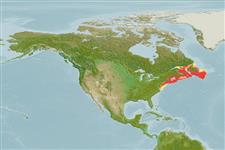>
Eupercaria/misc (Various families in series Eupercaria) >
Labridae (Wrasses)
Etymology: Tautogolabrus: Plural of the word "taut", an Indian Brazil name translated by Roger William from f the Narragansett, "tautauog" = sheepshead + Greek, labros = furious.
More on author: Walbaum.
Environment: milieu / climate zone / depth range / distribution range
Ökologie
seewasser riff-verbunden; tiefenbereich 10 - 128 m (Ref. 5951). Temperate; 54°N - 36°N, 77°W - 48°W
Western Atlantic: Newfoundland and Gulf of St. Lawrence in Canada to Chesapeake Bay in USA.
Size / Gewicht / Alter
Maturity: Lm ? range ? - ? cm
Max length : 44.0 cm TL Männchen/unbestimmt; (Ref. 49746); max. veröff. Gewicht: 1.0 kg (Ref. 7251); max. veröff. Alter: 6 Jahre (Ref. 1009)
Inhabits shallow, inshore waters, living on or near the bottom, often congregating in masses around wharves, wrecks and submerged seaweed. During winter they become torpid and remain inshore under rocks in shallow water (Ref. 5951).
Oviparous, distinct pairing during breeding (Ref. 205).
Robins, C.R. and G.C. Ray, 1986. A field guide to Atlantic coast fishes of North America. Houghton Mifflin Company, Boston, U.S.A. 354 p. (Ref. 7251)
IUCN Rote Liste Status (Ref. 130435: Version 2024-2)
Bedrohung für Menschen
Harmless
Nutzung durch Menschen
Fischereien: kommerziell; Sportfisch: ja; Aquarium: Kommerziell
Tools
Zusatzinformationen
Download XML
Internet Quellen
Estimates based on models
Preferred temperature (Ref.
123201): 0.5 - 10.6, mean 4.7 °C (based on 113 cells).
Phylogenetic diversity index (Ref.
82804): PD
50 = 1.0000 [Uniqueness, from 0.5 = low to 2.0 = high].
Bayesian length-weight: a=0.00955 (0.00625 - 0.01459), b=3.07 (2.95 - 3.19), in cm total length, based on LWR estimates for this species & (Sub)family-body (Ref.
93245).
Trophic level (Ref.
69278): 3.7 ±0.2 se; based on diet studies.
Widerstandsfähigkeit (Ref.
120179): mittel, Verdopplung der Population dauert 1,4 - 4,4 Jahre. (K=0.15-0.22; tmax=6).
Fishing Vulnerability (Ref.
59153): Moderate vulnerability (45 of 100).
Climate Vulnerability (Ref.
125649): High vulnerability (63 of 100).
Nutrients (Ref.
124155): Calcium = 14.3 [6.4, 24.3] mg/100g; Iron = 0.187 [0.104, 0.388] mg/100g; Protein = 18.8 [15.9, 21.0] %; Omega3 = 0.402 [0.227, 0.719] g/100g; Selenium = 8.17 [3.87, 16.92] μg/100g; VitaminA = 70.6 [18.5, 323.9] μg/100g; Zinc = 0.606 [0.400, 1.049] mg/100g (wet weight);
